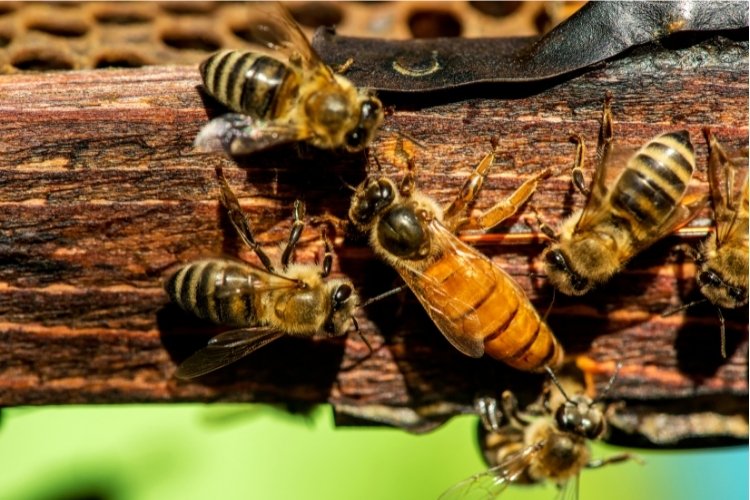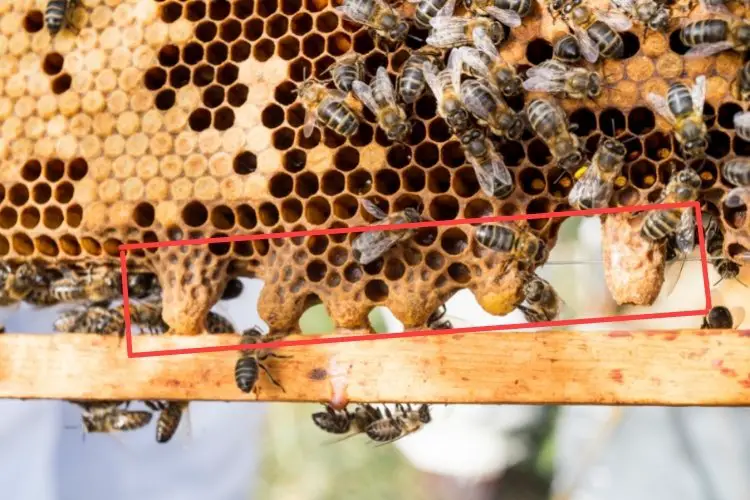The queen is the most important honey bee inside any hive. Without a healthy laying queen, a colony cannot survive. That’s because most worker bees only live for a few weeks. If the queen doesn’t lay enough eggs to repopulate the bees that die off, the colony can’t survive. To ensure they always have a healthy laying queen, bees turn to a strategy known as supersedure.
Supersedure is when a honey bee colony raises a new queen to replace its existing one. This happens when their queen either becomes ill or approaches old age, and she can no longer lay as many eggs as before. The old queen is superseded by one of her daughters, who takes her place as the new matriarch of the colony.

Supersedure Is Completely Normal For Honey Bees
Supersedure is a natural, normal behavior for honey bees. They need to ensure the survival of their colony, after all. When an old bee is no longer capable of laying enough eggs, she has to be replaced with one that can do the job.
One way to think about this process is by looking at examples of supersedure in the human world. The first thing that might come to mind is when a particular commercial product is superseded by another.
Takes cars, for example. When a particular model of car sells very well, the manufacturer has no reason to replace it. However, as sales diminish over time, they might choose to replace the model with something more modern. The old model is superseded by the new.
The situation is more delicate for honey bees than automotive manufacturers, though. If a carmaker has one poorly performing model, another can pick up the slack. But honey bees only have one queen – if they’re incapable of doing the job, she has to be replaced. They need to make sure the queen is young, healthy and strong, because she must survive winter at all costs.
You see, queen honey bees stop laying eggs during winter… and they don’t start again until the weather starts to warm up. If a queen dies during this time, there are no eggs the colony can raise as a replacement. And without a new queen, they will die.
That’s why, if a queen is old or unhealthy and there’s a risk she won’t survive the cold weather, a bee colony will replace her before winter begins.
How Do Bees Know When To Supersede A Queen?
Queen honey bees give off pheromones, which are chemical scents that change the behavior of other bees when released into the air. Their pheromones signal to the workers that she is the matriarch of the colony.
While a queen is healthy, she gives off a strong pheromone. This signals to the workers that she is boss – they’ll take care of her every need, feed her, groom her and clean up after her.
However, if the queen gets old or sick and her ability to lay diminishes, her pheromones change. Workers are able to detect this change. That’s what kickstarts the supersedure process.
When this happens, workers will build supersedure cells to house eggs for a new queen. The number can vary, but most colonies usually construct between 1-3 cells.
When Do Honey Bees Supersede?
Supersedure occurs when the amount of available pollen declines and brood production begins to slow down. Typically, this is during summer or early in the fall (autumn).
Superseding at this time of year gives the colony enough time to raise a new queen before winter. If a colony waits too late, however, supersedure may not be successful.
As winter draws closer, there are fewer drones for a virgin queen to mate with. That’s because drones (male bees) are kicked out of the hive before winter, as they are a drain on resources and eat a lot of food. Their only real purpose is to mate with queens and, given this doesn’t happen during winter, they are left to die off.
Because of this, superseding too late in the season can result in hiving raising a virgin queen that’s unable to mate. This can be disastrous for a colony and leave them without a laying queen.
Does The New Queen Kill The Old Queen During Supersedure?
The first healthy queen to emerge will seek out and destroy the other supersedure cells using her stinger. If she let the others emerge, she would have to kill live queens who fight back, and there’s a good chance she would get injured.
Once she’s ready, the virgin queen will depart for her mating flight. She will travel to a nearby drone congregation area, where she will mate mid-flight with a drone and store the sperm in her spermatheca. Most queens perform multiple mating flights over the course of a few days, as long as the weather is suitable.
After she has finished mating, the new queen is ready to take over the hive from the old queen. There is some debate among beekeepers about what happens next. Some believe the old queen is killed by the new queen or by worker bees, or she is kicked out of the hive and left to die.
However, other beekeepers report seeing both the old and new queen together inside the hive. They believe the old queen’s pheromone levels reduce enough so that she isn’t seen as a threat. Eventually, her pheromone diminishes so much that workers stop feeding her, and she dies.
It’s difficult to know which of these is true, because most commercial beekeepers replace their queens themselves. A lot of hobbyist beekeepers don’t mark their queens, so supersedure takes place without them even realizing it. However, I was able to find one peer-reviewed article that says the second version of events is more accurate, with both the old and new queen living together in the same hive until the old one dies.
Commercial Beekeepers Replace Queens About Once A Year
Supersedure rarely happens in commercial apiaries because beekeepers routinely replace queens themselves. Given they have so many hives, it’s impossible for them to tell which ones have sick or aging queens and which don’t. They also have a financial stake in the strength of the colonies, so they don’t leave anything to chance.
Rather than let the bees decide when to supersede, most commercial beekeepers requeen every year. This involves finding the old queen inside a hive, killing it, and replacing it with a mated queen that’s been specially bred for her favorable temperament. Beekeepers mark their queens to make them easier to locate.
Personally, I have only replaced my queens on a couple of occasions. The first time it was because I had an aggressive hive that was causing problems for my neighbors and me. Unfortunately, after I replaced the queen, I introduced one from a breeder – and the colony killed it. I ended up selling the hive to someone who had more experience with aggressive bees than I did.
The only other time I have replaced a queen was in a different hive, where the queen was about two years old. At the time, I was reasonably new to beekeeping and did so on the advice of some more experienced beekeepers at my local club. They helped me to replace the queen, and the transition was successful.
I haven’t replaced any queens since, and they are doing fine. I’m not sure whether I will continue to replace them every couple of years or simply let the bees decide when to supersede instead (I like the idea of leaving it up to the bees as it’s a more natural thing to do).
Queen Cells Vs Supersedure Cells: How To Tell The Difference
Spotting queen cells in your hive may give you a fright because they look quite different from cells used to raise drones and workers. They are much larger, around an inch long (2.5cm), and look like a peanut shell.
The problem is that you won’t be able to tell the difference between swarm cells and supersedure cells – not from the appearance, at least. So if you see queen cells, you might be afraid your colony is preparing to swarm. While swarming is natural for honey bees, many beekeepers don’t like it because it involves the hive splitting in two (and therefore reduces the honey-making capacities of the hive).
There are two main clues that will help you tell the difference between queen cells and supersedure cells:
1. The location of the cells
Swarm cells are typically constructed around the outer edges of the comb. Supersedure cells, on the other hand, are usually built in the middle of the comb. This is not always the case – but it’s a good rule of thumb to go by.
2. The number of cells
When bees are replacing the queen, they usually build between one and three supersedure cells, all close together. If the colony is preparing to swarm, however, they will build a lot more, and you’ll sometimes see dozens of cells hanging from the edge of the comb.


To summarize, if you see one, two or three queen cells in your hive, all of which have been built in the middle of the comb, they are most likely supersedure cells. If you see more than three queen cells, all hanging from the outer edge of the comb, they are almost certainly swarm cells.
What Should You Do With Supersedure Cells?
If you are sure your colony has built supersedure cells, the next logical question is, what should you do with them? If there are more than one, some beekeepers choose to destroy the others. They don’t want to risk multiple queens emerging at the same time and getting injured when they fight.
Other beekeepers would say to leave the supersedure cells alone rather than cutting them out. I tend to be in this camp.
If you’re happy for your bees to decide when to replace the queen, then you are better off trusting them to do it properly. If you remove all supersedure cells except one, what happens if something goes wrong with that queen and she never emerges?
Of course, the decision is up to you as the beekeeper… but when in doubt, I usually err on the side of trusting the bees to know what’s best.
Final Thoughts…
Supersedure in honey bees is when the colony replaces a sick or aging queen with a new one. The new queen is the one doing the superseding. The old queen is the one being superseded.
While supersedure is a completely normal process, many beekeepers choose to instead replace their queens themselves on a regular basis (once every year or two). This gives them greater control over the characteristics of the queen and her laying abilities.
